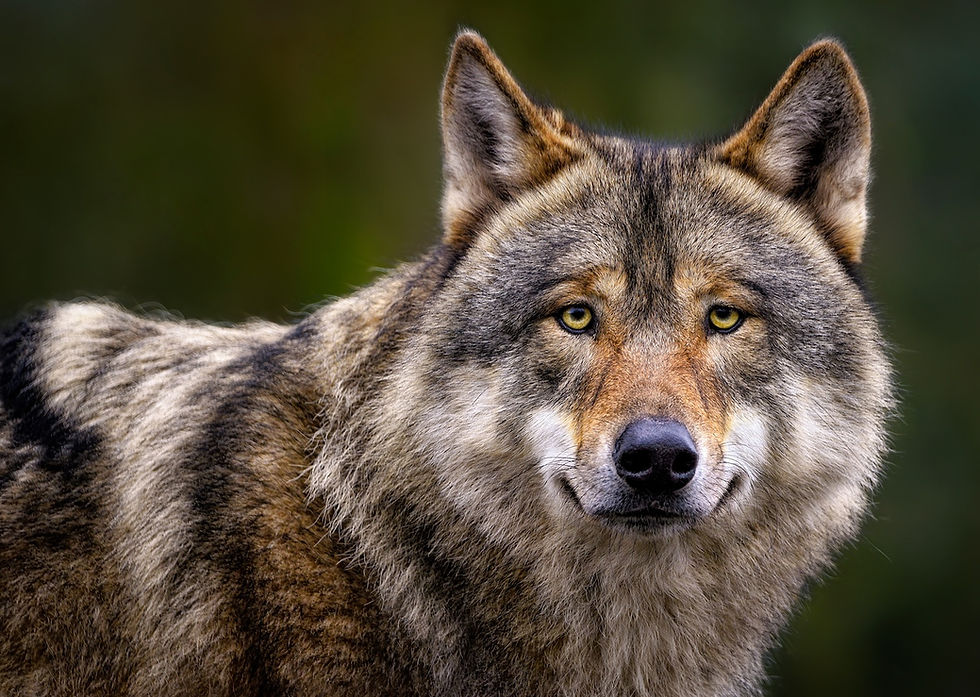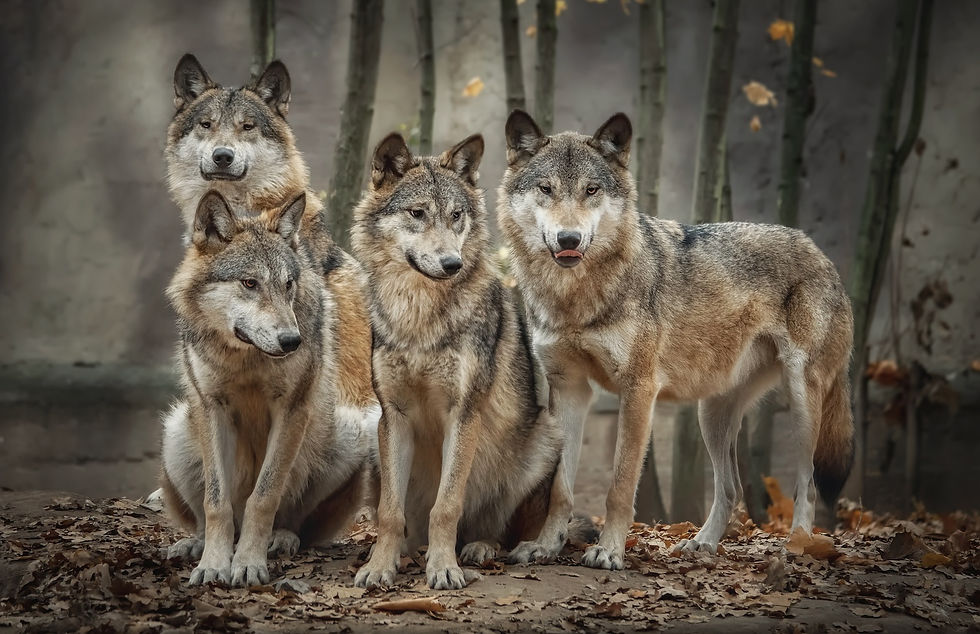They are playful, intelligent and devoted to family. They care for their sick, educate their young and have complex social lives. Are we talking about people? No, these are gray wolves.

Canis lupus, as gray wolves are known scientifically, look a lot like a big dog. They are the ancestors to your pet dog at home. Gray wolves are mostly gray or brown with lighter fur down their sides. Some have solid black or white coats. All have bushy tails, long legs and large feet.
They are the largest members of the dog family, coming in at 2 1/2 feet tall at their shoulders and up to 6 feet long including their tails. An adult male will weigh between 60 pounds and 130 pounds, while adult females are a little smaller at 45 pounds to 80 pounds.
Sometimes people confuse gray wolves with their relative, coyotes. Coyotes are smaller. They weigh less, and they are shorter and not as long. Gray wolves boast broad noses also known as snouts and rounded ears. Coyotes have narrow snouts and tall, pointed ears. Coyotes’ tails are usually down while walking, but a gray wolf carries its tail elevated.
How are your senses? Gray wolves have great hearing, sight and sense of smell. This comes in handy when looking for a meal. By hunting together in a group called a pack, they can take down large herd animals like deer, elk, moose or bison. Think of it like when you are on a team. You can’t win the game alone, but if you work together, you have a chance! They also enjoy a snack of beavers, rabbits, fish and birds. They are most active at night.
Family life
Just like humans, gray wolves hang out with their families, which we call packs. Mom and dad take charge, raising their pups. Parents watch out for their kids, keeping them safe, feeding them, teaching survival skills and even playing together. Pups play a lot while growing up. They leap and prance. Their games are hide and seek and tag. Does that sound anything like your family?
Older wolf siblings look after their younger brothers and sisters by playing with them and finding dinner. Young wolves stay with their pack for at least two years, learning everything they need to know. Then they sometimes take off to join other packs or make their own pack. They are a lot like people; some wolves move far away from their parents when they grow up and others stay close to home.
Pack talk

Have you ever heard of a wolf howling at the moon? Naturalists say they aren’t actually saying hi to the moon; they just like to howl more frequently when there is more light at night. Howls can be heard from miles away, and each pack has a unique howl.
Wolves are great communicators. They just want to talk to each other — to call to another pack or warn each other of danger.
It’s not just howls, whimpers, whines, growls, barks, yelps and snorts. They also talk with smells made by their bodies. They can smell 100 times better than us. What to do with this superpower? Urinate to mark their territory and tell their family where they are.
Do you use body language to communicate? So do wolves! They might wag their tail to ask a friend to play or furrow their forehead, show their fangs or growl if they are angry.
Wolves in Illinois?
The first written record of wolves in our neck of the woods comes from Ojibwe people. They saw wolves as role models for young men learning to hunt. You had to be really brave to go after massive mammals like bison with only your teeth! They also admired how wolves took care of their family members, just like people should. In Ojibwe stories, wolves and people are the brothers, and they must look after each other.
Words to know
Colonist: A settler or inhabitant of a colony.
Federal: Relating to the central government of the United States.
Furrow: A groove or rut in the surface of something.
Prance: To move with high, springy steps.
When colonists came into the area, they had bad thoughts about wolves because of fairytales like “Little Red Riding Hood.” In these stories, wolves are always the bad guys. Plus, colonists drove out most of wolves’ food, so gray wolves hunted the new food that people brought in, like cows and sheep. You can imagine farmers didn’t like that.
This animal, which once roamed almost all North America, including Will County, was hunted. The government paid people to kill wolves. Large wolf-hunting parties made wolf hunting a sport. Sometime between 1860 and 1900, there were no more wolves in Illinois.
Environmental impact
Why does that matter? It turns out wolves are great for their environment. They keep deer populations in check, which benefits other species and the environment. Because deer don’t overgraze, there are more plants for other species. Small saplings have a better chance of turning into full-grown trees. Wolves also provide carrion, or dead animal scraps, for other hungry critters to snack on.
Legal status
After almost facing extinction in the continental United States, some amazing people worked to guard gray wolves. Now laws watch out for them. They are federally protected under the Endangered Species Act. In Illinois, they are listed as a state endangered species.
We don’t have packs who live in Illinois full time. We only have the rare visitors who come in from Wisconsin or Michigan. There have been 11 confirmed wolf sightings in Illinois since 2002. The closest was in Grundy County in February 2015.
____________
Follow Willy's Wilderness on Facebook for more kid-friendly nature stories and activities.





Komentáře